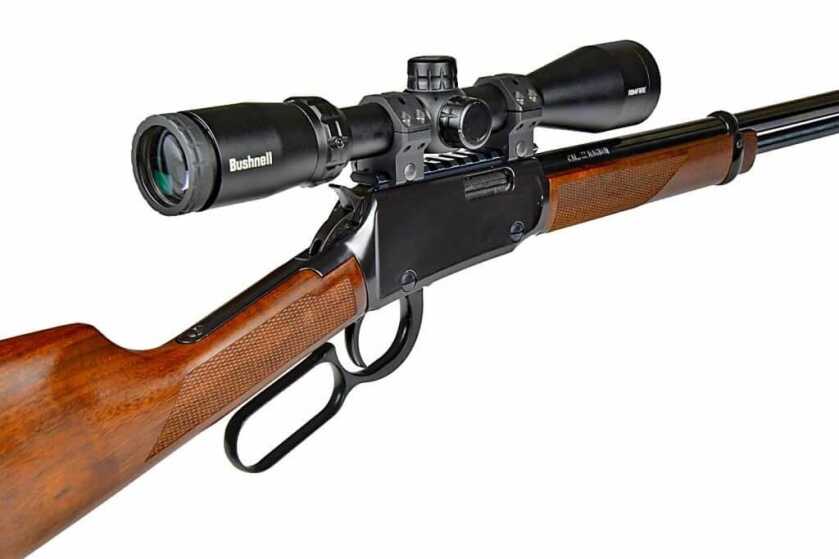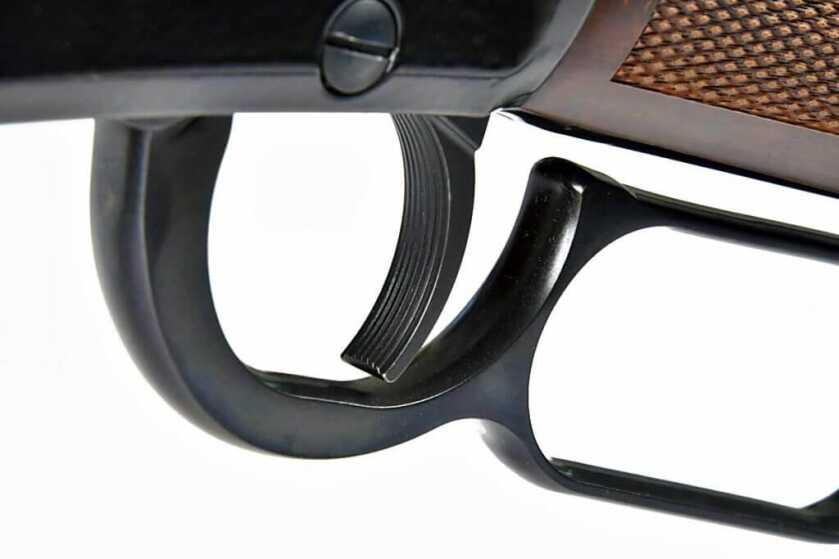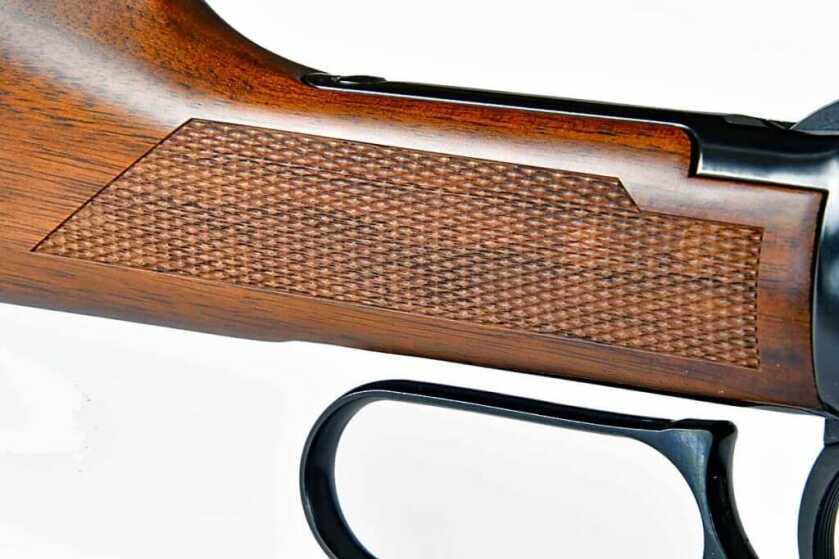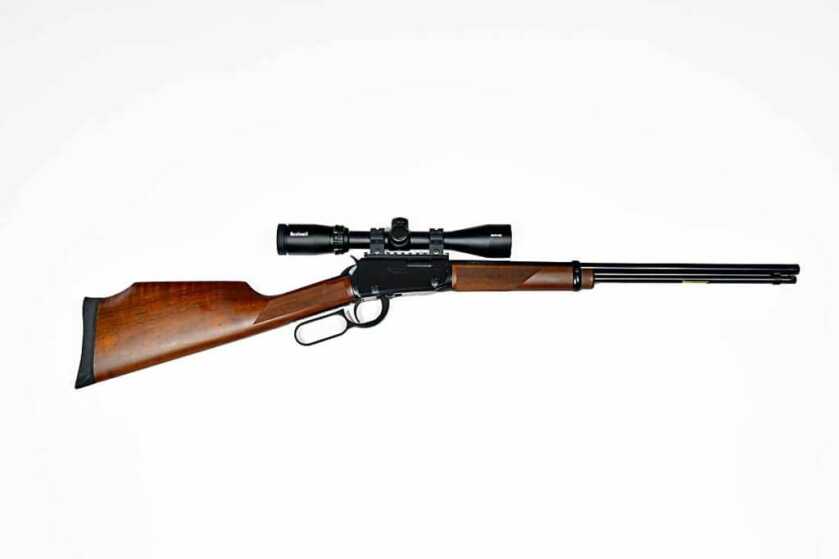
Even at a quick glance, it’s immediately obvious to lever gun fans that there’s something different about the new Henry Magnum Express rifle, which is chambered in .22 WMR. The rifle is entirely devoid of fixed sights. While that may seem to be a sacrilegious omission to some, it’s entirely by design. The Magnum Express is specifically designed to be used with optics, and that’s a big plus for those who like to hunt small game or dispatch varmints with the most potent .22 rimfire cartridge, or those with aging eyes that don’t work so well with iron sights.
The rifle is optics-ready out of the box with a pre-installed Picatinny rail atop the receiver that provides a solid base for mounting a scope or other optic. Because the stocks of lever-action guns often have a fair amount of drop at comb, that can sometimes create an issue with getting proper eye alignment with a scope atop a lever gun. Henry addressed that with a Monte Carlo stock design that results in comfortable, quick, and instinctive eye alignment with an optic, and I found that the arrangement worked perfectly with the new Bushnell Rimfire rifle scope I used for testing the rifle.

Before we get to the results of my testing, which left me impressed with the gun’s accuracy, a few words about the utility of the 22 WMR cartridge are in order. I have long been a fan of the 22 Winchester Magnum Rimfire cartridge because it shoots flatter and hits harder than the 22 Long Rifle. Comparing both rounds loaded with 40-grain bullets, the 22 WMR has roughly twice as much energy at the muzzle than the 22 LR, and with the right bullets, it delivers better penetration and expansion. I’ve killed everything from cottontails and jackrabbits to ringtail cats, raccoons, and foxes with the 22 WMR. I haven’t killed coyotes with it, but I know a number of people who have. The 22 WMR is, in short, a great round for varmints and predators out to 125 yards or so.
That’s especially true with a fast-handling rifle like the Magnum Express. The rifle’s scope-friendly Monte Carlo stock is made of actual walnut, which is a rare-enough commodity at a time when dealers’ rifle racks seem to hold nothing but synthetic-stocked guns. The walnut on my test rifle wasn’t of the high-dollar, premium-grade variety, but it had nice grain, color, and figure, and I found it quite pleasing to the eye. The stock has nicely executed checkering in the grip and forend areas, and it sports a quality soft rubber recoil pad. That’s not really needed on a rimfire rifle, but it dresses up the gun nicely. The overall look is one of understated elegance.

The rifle employs a round, blued-steel, 19.25-inch barrel that squeezed a little more velocity out of 22 Win. Mag. ammo than I anticipated. Riding beneath the barrel is Henry’s iconic tubular magazine, which holds 11 rounds. Loading is via a cartridge-shaped port on the forward bottom end of the magazine tube. I found loading cartridges a little tricky, at first, until I realized that simply angling the cartridges into the cutout base-first was the way to go. When I did that, rounds dropped into the magazine tube as fast as I could push them in.
The heart of this gun is, of course, Henry’s lever action. Like all Henry rifles I’ve tested, this one cycled with exceptional smoothness, and the lever had a fairly short throw. The gun loaded, fired, extracted, and ejected rounds without a single issue in testing. I even found that I could, with a bit of care, load single rounds into the rifle via the ejection port while testing the gun at the bench. The black finish on the action nicely matches the finish of the blued barrel, and the wood-to-metal fit was quite good.

People who love lever-action guns tend to love them for several valid reasons, including the fact that they are easy to operate quickly. They are, in a word, handy, and the Magnum Express is no exception. With a weight of just 5.5 lbs. and an overall length of just 37.5 inches, it’s easy to carry this gun through the woods all day and swing it quickly to get on target. The length of pull is 14 inches, which should fit most shooters nicely. In testing, this gun was a joy to run, and I found it easy to trigger quick follow-up shots without removing my eye from the scope.
Lever guns as a class aren’t exactly famous for having exceptional triggers, but the trigger on the Magnum Express proved to be a pretty decent one. It broke at an average pull weight of 3 lbs., 2 oz. The trigger had a small amount of creep in it, but it was consistent and predictable to the point that, with a very slow trigger pull, the trigger behaved almost like a two-stage trigger. In shooting at game, you’ll likely never notice it. Notably, the rifle has no visible external safety. Rather, it employs a ¼ cock safety so you can safely carry the gun with a round chambered and the hammer in the ¼-cocked position. With a scope mounted, space is a little tight for manually manipulating the hammer with your thumb, but this can easily be addressed with an aftermarket hammer extension. Henry makes one that fits all Henry rimfire rifles.

While I normally test rimfire rifles at 50 yards, and .22 WMR ammo isn’t especially noted for producing stunning accuracy at longer distances, I decided to push the envelope and test the Henry at 100 yards to see what the trim little gun could do. The results demonstrated that the gun was plenty accurate for most purposes at that distance. Of three loads tested, the worst of the bunch produced 1.69-inch average groups at 100 yards. Things tightened up a bit with Hornady’s Critical Defense load with a 45-grain FTX bullet. That load clustered bullets into average groups of 1.30 inches with a 1.15-inch best group. The top performer tested was Remington’s Premier Magnum Rimfire load using a 33-grain AccuTip-V boat tail bullet. That load delivered the best group measuring just 0.72 inches and average groups of 1.09 inches. All tested loads shot sub-MOA groups at 50 yards.
All testing was done using Bushnell’s new 3-9x40mm Rimfire scope. This lightweight scope, which proved to be a perfect companion to the Henry rifle, has a one-inch tube and features crisp ¼ MOA adjustments, ultra-wide-band multi-coated optics, and an IPX7 waterproof rating. Parallax correction is preset at 50 yards, and you can use Bushnell’s ballistic app to get accurate hold-over information.
Velocities, interestingly, were mildly faster than factory-stated numbers for the two most accurate loads. The Remington AccuTip-V load stepped out 59 fps faster than the factory-stated velocity of 2,000 fps, and I clocked the Hornady Critical Defense load, with its heavier bullet, at 1,816 fps, which is 116 fps faster than the advertised speed.

The rifle has no sling swivel studs, but Henry makes a special leather sling that can be used with the rifle without the use of studs.
If you enjoy hunting small game and predators and want a little more punch than you’ll get with a 22 LR, the Henry Magnum Express may be just what you’re looking for. Make no mistake about it – this rifle is designed purely for hunting, and it’s one that any hunter would be proud to carry in the field. It also wouldn’t be a bad choice to have around as a survival tool. The rifle has an MSRP of $622.00, and all Henry firearms come with a 100 percent lifetime satisfaction guarantee.

SPECIFICATIONS
Henry Magnum Express
Caliber: 22 WMR
Action: lever action
Barrel: 19.25-in. 1:16 twist
Finish: Blued
Magazine: 11-round tubular
Stock: walnut
Sights: None, Picatinny rail installed
Safety: ¼ cock
Overall length: 37.5 in.
Weight: 5.50 lbs.
CONTACTS



I sure wish Henry would make a leaver 22 Hornet….
I won’t even look at a rifle without iron sights!
Damn straight.
The 22 Magnum is not the most powerful rimfire cartridge. The 17 WRM pushes a bullet 3000 fps. It has been out about 10 years. Unfortunately few quality rifles in the caliber were made. The Savage Bmag was junk so I sold my 17. Also MOA at 50 yards would be 1/2” if it was a thing.
The article said the .22M is the most powerful .22 rimfire, not the most powerful rimfire cartridge.
Thank you regarding the MOA comment. It is high-time everyone stopped using that stupid, mistaken conversion of an optical term as a ballistic term. It should be obvious that since it does not shoot “MOA” at 100 yards, that saying it shoots “MOA at 50 yards” is nonsense.
I have found that with few exceptions, the .22 WMR chambering is lousy as to accuracy in many guns.
After 3 such firearms, I gave up on the cartridge.
Well big Al 45 I am sorry to hear that
I have had great success with the 22 wmr
My ruger American is the best
The cz is second
And the revolver but it is only a 4.75” barrel
And my dad has a savage he raves about
Have u tried using open sights before mounting a scope
carry my kel-tec pmr 30 while putting up hay in the summer have killed 3 coyotes one at about 100 yards
I disagree with Mr Jones, above, as I have packed Walnut stocked rifles all over Alaska, the rain forests of far Western Wa state and much of Zimbabwe. I will take a walnut sock all day every day. Synthetic would be an abberation on this gun. But speaking of abberations, this is the word to use to describe that awful hump on the stock and the lack of good iron sights. The sights on my Henry 22lr levergun are terrific and being a true square notch plus squared off blade front are infinitely better than the ‘tits on a boat’ level semi buckhorns on Winchester and most other lever action rifles. A levergun just doesn’t look ‘right’ without some irons on it and that awful hump. A plain stock on this rifle puts one’s eyes in perfect position if one is using the correct low powered variable scope that would be the correct match up for such a rifle in this chambering. My Henry 22lr has a gloss Leupold 1x-4x straight tube and my traditionally stocked big bore 94 in .307 is topped with a VERY useful Weaver KASPA 30mm tube 1.5-6x optic. I am in the market for a new 22WMR rifle this weekend and may very well go with the standard lever action from Henry for the reasons mentioned. Anxious for this weekends Gun show to actually fill this niche’ in my gun safe
Article says MSRP is $622.00.
As a Hunting Rifle, this Henry has three deterrents.
1. Since the hammer is virtually unreachable, a hammer extension should be standard equipment on this gun, not an “accessory”.
2. Carrying this gun across the woods and fields in any weather almost REQUIRES the stock be synthetic.
3. Sling studs should be available as standard equipment. A sling would be almost mandatory and anything mounted on anything but sling studs would regulate the gun to hillbilly status.
Wow. Be all and end all.
I have an incredibly beautiful pump action .22 from the 1920’s. How on earth did that rifle make it this far without a hideous looking synthetic stock? In its 100+/- years of existence I’ll bet it was exposed to moisture. Perhaps it needed a little maintenance here and there. Some refer to dents, dings and scratches acquired in the field as “character”.
If one balks at the price of a hammer extension, one probably can’t own this very handsome firearm to begin with.
Gee, I wonder how so many lever guns got carried around all those years with those silly ‘ol wood stocks, and how is it that so many Deer and other critters fell to those silly ‘ol wood stocked guns?
“Requires”?!?!?!?
How much is the gun
Can you please give me a price
Both of you, read the article
Very nice article
Henry’s are very nice the reason why the 33 grain was more accurate was because the twist in the barrel is 1 in 16
It needs to be 1in 14 for the 22 wmr when using heavier bullets u need a faster rate of twist to stabilize it
This is a common mistake manufacturer’s make or they are just being CHEAP
Ruger offers a 1in 14 twist
So I will not be buying a Henry
Im buying one! It will replace the Winchester XTR 94/22 Magnum I foolishly let slip away back in ’79. The fact that I dont even remember what gun was purchased to replace it proves what a fool I am. But I remember that gun! The 22 Magnum is my favorite cartridge in the world.I can see myself now- tramping the fields and woods with my new Henry and my Ruger Super Single Six with the magnum cylinder installed carried in an El Paso Sadlery tanker holster.
very nice looking gun but why are the barrels so short just wondering if it can be made with a 26 in barrel.
I’ve got the Henry 22 Mag with Octagon barrel and Iron sights, I installed a small 3x7x20 scope it’s short and skinny I love this gun also have the same gun in 22 S/L/LR,
How much is this gun?
Read the article